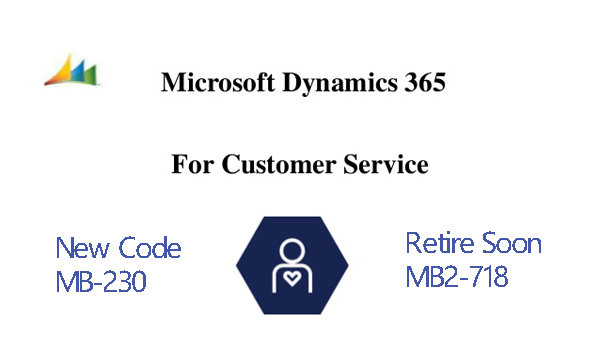MB-230 Practice Test Questions - Microsoft Dynamics 365 for Customer Service
MB-230 Microsoft Dynamics 365 for Customer Service is the new exam instead of MB2-718 which will be retired on August 31, 2019. Passquestion provides you valid MB-230 Practice Test Questions to help you get certified easily. If you want to get your Microsoft Certified: Dynamics 365 for Customer Service Functional Consultant Associate Certification, you should pass both MB-230 and MB-200 Microsoft Dynamics 365 Customer Engagement Core exams.

Exam MB-230: Microsoft Dynamics 365 for Customer Service
Passing MB-230 Microsoft Dynamics 365 for Customer Service validates the skills and knowledge to implement omnichannel solutions that focus upon service, quality, reliability, efficiency and customer satisfaction.
Exam MB-230 Skill Measured
Perform configuration (25-30%)
Manage cases and the knowledge base (30-35%)
Manage queues, entitlements, and SLAs (25-30%)
Configure voice of the customer (15-20%)
Who Should Take this MB-230 Exam?
Candidates for this exam are Dynamics 365 Customer Engagement functional consultants with customer service expertise. Candidates are responsible for implementing omnichannel solutions that focus upon service, quality, reliability, efficiency and customer satisfaction.
Candidates design and implement service management visualizations and reports provided by and in collaboration with the Solution Architect. Candidates collaborate with the Customer Engagement administrator to implement and upgrade Power platform components, including knowledge base, and Voice of the Customer.
Candidates must have strong applied knowledge meeting user needs through the Dynamics 365 Customer Service, including in-depth understanding of cases, knowledge base, queues, entitlements, Service Level Agreements (SLAs), visualizations, and Unified Service Desk.
Candidates should understand industry terminology, priorities, standards, methodologies, customer service operations, and best practices. Candidates should include a comprehensive understanding of the Customer Service application's role in relationship to the Dynamics 365 suite of applications along with a basic understanding of the solution architecture and quality assurance.

Share Microsoft MB-230 Practice Test Questions Below:
1.You use Dynamics 365 for Customer Service.
You need to create business process flows.
Which three entities can you use? Each correct answer presents part of the solution.
NOTE: Each correct selection is worth one point.
A. Goal
B. Case
C. Letter
D. Social activity
E. Rollup queries
Answer: BCD
2.You are configuring a single business process flow in Dynamics 365 for Customer Service.
You need to design the business process flow.
What should you do?
A. Merge peer branches to a single stage when merging branches.
B. Span the process across 10 unique entities.
C. Combine multiple conditions in a rule by using both the AND and OR operators.
D. Use 40 steps per stage.
Answer: A
3.A company has the following business units:
- Call center
- Customer service
- Digital response
- Escalation
The security roles have not been modified. The customer service business unit is the parent of all other business units. Each business unit has its own queues. Customer service cases are routed to the appropriate individuals by using the queues.
You need to ensure that a specific user within the customer service business unit can read all queues within the parent and child business units.
Which security role should you assign to the user?
A. Customer service manager
B. Scheduler
C. Customer service representative
D. System customizer
Answer: A
4.You are a customer service representative using Dynamics 365 for Customer Service.
You need to identify and eliminate duplicate cases.
What should you do?
A. Configure Dynamics 365 AI for Customer Service
B. Use business rules
C. Merge cases
D. Use parent-child case relationships
Answer: B
5.You are a system administrator for Dynamics 365 for Customer Service.
All child cases must inherit the product, customer name, case title, and case type from the parent case. Parent cases must not be closed until all child cases are closed.
You need to configure cases.
What should you do?
A. Set the closure preference setting to Don’t allow parent case closure until all child cases are closed.
B. Set the closure preference setting to Don’t allow parent case closure until all child cases are closed. In Settings, navigate to Customizations. On the case entity, update the Incident-Incident Resolution case relationship field mapping to include the fields.
C. Create a business rule.
D. Add the product and case type fields as fields that child cases will inherit from the parent case. Set the closure preference setting to Don’t allow parent case closure until all child cases are closed.
Answer: D
- TOP 50 Exam Questions
-
Exam
All copyrights reserved 2025 PassQuestion NETWORK CO.,LIMITED. All Rights Reserved.

